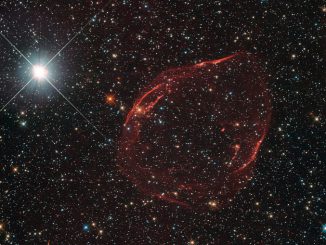
Conventional wisdom holds that high-energy cosmic rays crashing into Earth’s atmosphere at the speed of light, triggering showers of cascading particles, are generated in powerful supernova blasts.
Not so fast, researchers say.
As it turns out, supernovae, which do indeed generate high-energy gamma rays, are not powerful enough to explain the petaelectronvolt (PeV) energies observed with the most extreme cosmic ray events. Instead of supernovae, new research suggests, star clusters featuring closely packed type O and type B stars are responsible, acting as so-called PeVatron accelerators.
“Cosmic rays below PeV energy are believed to come from our galaxy, but the question is what are the accelerators that can produce them?” said team leader Petra Huentemeyer, professor of physics at Michigan Technological University.
Team member Henrike Fleischhack, a researcher at Catholic University/NASAGSFC/CRESST II, said supernovae “do accelerate cosmic rays, but they are not able to get to highest energies. There have been several … hints that star clusters could be part of the story. Now we are getting confirmation that they are able to go to highest energies.”
Star clusters made up of suns born in the wake of supernova blasts can feature massive type O and type B stars packed by the hundreds in areas as “small” as 30 parsecs (108 light years) across.
“Spectral type O stars are the most massive,” said Binita Hona, a recent graduate of Michigan Technological University. “When their winds interact with each other, shock waves form, which is where acceleration happens.”
Cosmic rays created in supernova blasts cannot be confined long enough to reach the energies seen in the most extreme examples. But powerful magnetic fields in star clusters can do just that.
“Supernova remnants have very fast shocks where the cosmic ray can be accelerated. However, they don’t have the type of long confinement regions,” said Sabrina Casanova at the Institute of Nuclear Physics Polish Academy of Sciences in Krakow. “This is what star clusters are useful for. They’re an association of stars that can create disturbances that confine the cosmic rays and make it possible for the shocks to accelerate them.”
The research, published in two papers in Nature Astronomy and Astrophysical Journal Letters, is based on 1,343 days of measurements using the High-Altitude Water Cherenkov – HAWC – observatory near Puebla, Mexico. Physicists at HAWC trace cosmic rays by measuring the secondary rays generated when gamma rays from deep space hit Earth’s atmosphere.
“When gamma rays interact with the atmosphere, they generate secondary particles in particle showers,” said doctoral student Dezhi Huang. “When particle showers are detected at HAWC, we can measure the shower and the charge of secondary particles. We use the particle charge and time information to reconstruct information from the primary gamma.”
The researchers plan to work with the Southern Wide-field Gamma-ray Observatory (SWGO), now in the planning stages, to look for more candidate star clusters in the southern sky.



